Pictures › Wildlife › People & Places › Country Know-how › Food
THE BIG PICTURE

TIMELESS SUNSET
The setting sun casts long shadows over the shapely boulders at the tiny cove of Porth Nanven in Cornwall’s Cot Valley. The beach is also known as ‘Dinosaur Egg Beach’ because of its large rounded stones, which were smoothed by a prehistoric ocean over 120,000 years ago. Although the beach mainly consists of large ovoid pebbles, at low tide the sand is revealed. In the distance, the craggy twin peaks of the Brisons islet, a busy nesting site for seabirds, seem to cradle the golden sun.
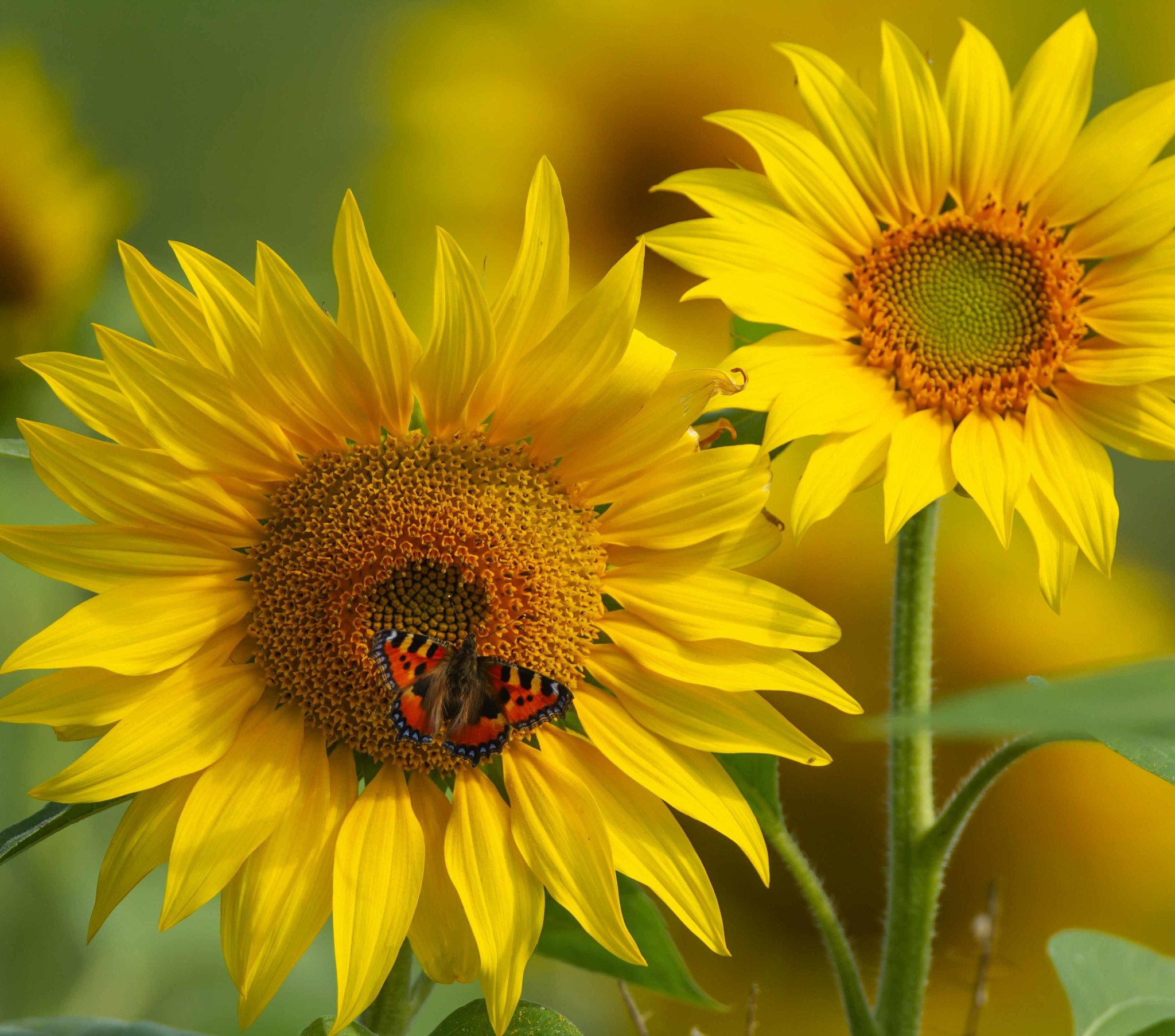
SUNFLOWER SPLENDOUR
The flamboyant colours of the small tortoiseshell butterfly are here overshadowed by the brilliant yellow of a sunflower as the insect feeds on the bloom’s nectar. The butterfly’s artistic mix of blue, black, orange and red is almost camouflaged against the densely packed sunflower head, which in fact comprises up to 4,000 little flowers clustered together. As a result, the plant is rich in pollen and nectar, and popular with insects. Butterflies use their proboscis (tubular mouthpart) to sip nectar from each tiny individual bloom.
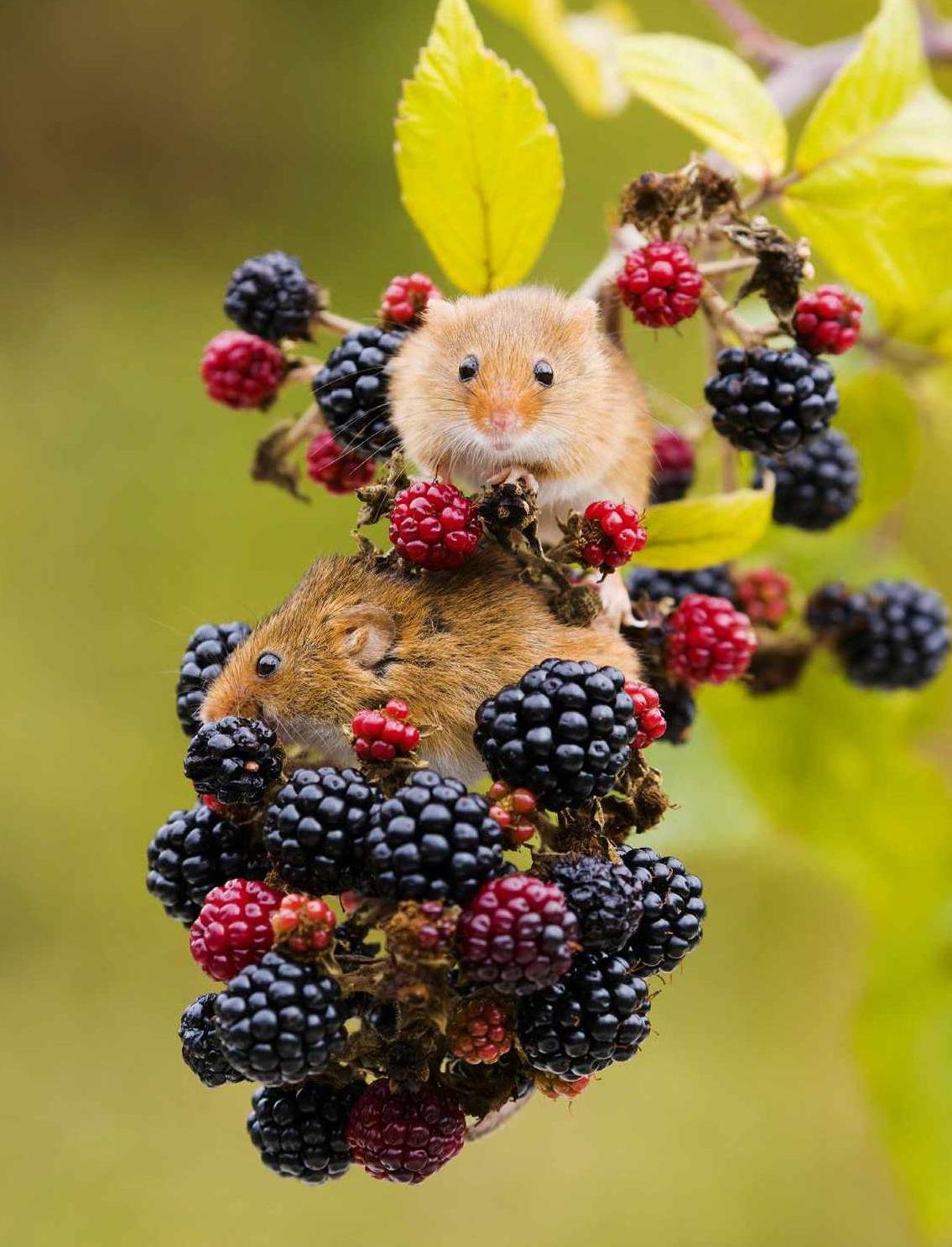
BERRY MICE
Two adult harvest mice live up to their name by gathering and munching on blackberries in Suffolk. Agile gymnasts, harvest mice are the only British mammal to build their nests of living woven grass above ground, so balancing on a bramble stem proves no challenge. They are much smaller than other British mice, weighing just four to six grams and measuring between five and seven centimetres in length. See a lovely image of harvest mice balancing on an ear of wheat, in this month’s Readers Photos.
EVENTS
Step into September
Discover the joys of the countryside with a walking event this month

Walk the Chalk, East Sussex
Walk the Chalk is a five-day celebration of the newly renamed King Charles III England Coast Path, which, when complete, will be the longest coastal trail in the UK. The event (20–24 Sept) will take place around the coastal grasslands and pebble beach of Cuckmere Haven, where visitors can join a guided walk and learn about the local heritage, fossils, wildlife and folklore. walkthechalk.org
YHA Festival of Walking, England and Wales
To inspire new and seasoned walkers, YHA has produced more than 180 free, downloadable walking routes, all starting and finishing at a youth hostel. Alongside these self-guided walks, there will be guided social walks from 3 Sept–19 Oct. yha.org.uk/festival-of-walking
22–24 September
Moffat Eagle Festival

BBC wildlife broadcaster and ornithologist Iolo Williams will be the keynote speaker at Scotland’s Moffat Eagle Festival this year. Set in the Dumfries and Galloway town of Moffat, the UK’s first official Eagle Town, the weekend includes the Eagle Hill Fell Run, a motorbike event, chainsaw demonstration, live music and wildlife talks. goldeneaglessouthofscotland.co.uk

8–10 September
Redruth International Mining and Pasty Festival

Spanning three vibrant days, this West Cornwall festival kicks off on Friday with a special tribute to the region’s miners and the heritage of Redruth. On Saturday there will be a street market with a food village, stalls, music, pasty competitions, pasty trail and a new pasty relay. The festival concludes on Sunday at Victoria Park with a dog show, family games, space-hopper racing and more. discoverredruth.co.uk/pasty-festival
Plodcast highlights this month
Get active in nature
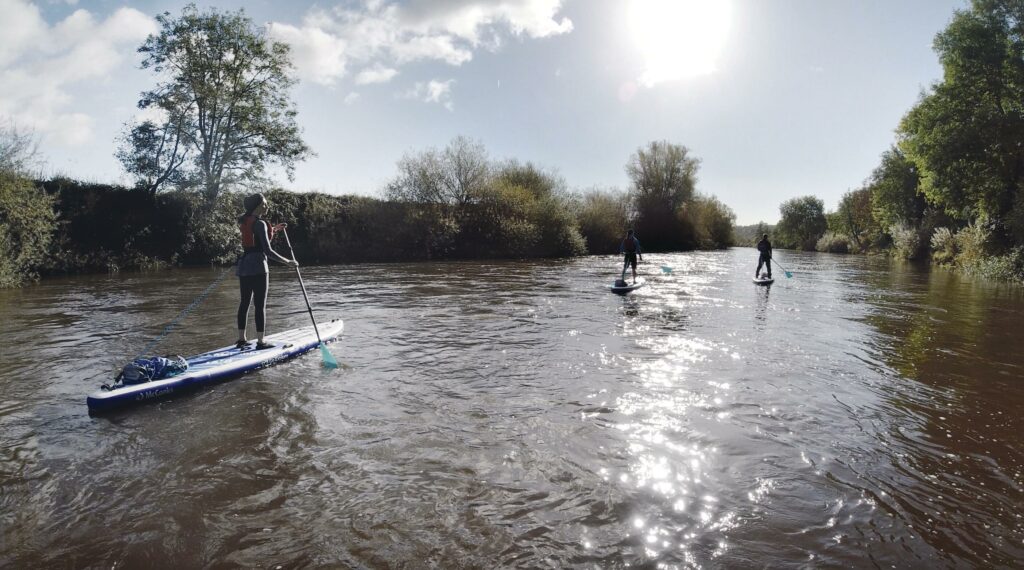
The Plodcast is BBC Countryfile Magazine’s nature and countryside podcast – with a fresh adventure published every week. Listening highlights this month include:
1. Exploring the poetry of moss and rainforests with Elizabeth-Jane Burnett, episode 202.
2. Soaking up nature’s beauty while paddleboarding the Wye (pictured), episode 203.
3. Roaming the eastern Bannau Brycheiniog (Brecon Beacons) on an eBike, episode 204.
Find the Plodcast on Apple, Spotify and all good podcast providers.
GET INVOLVED
Footpath friends
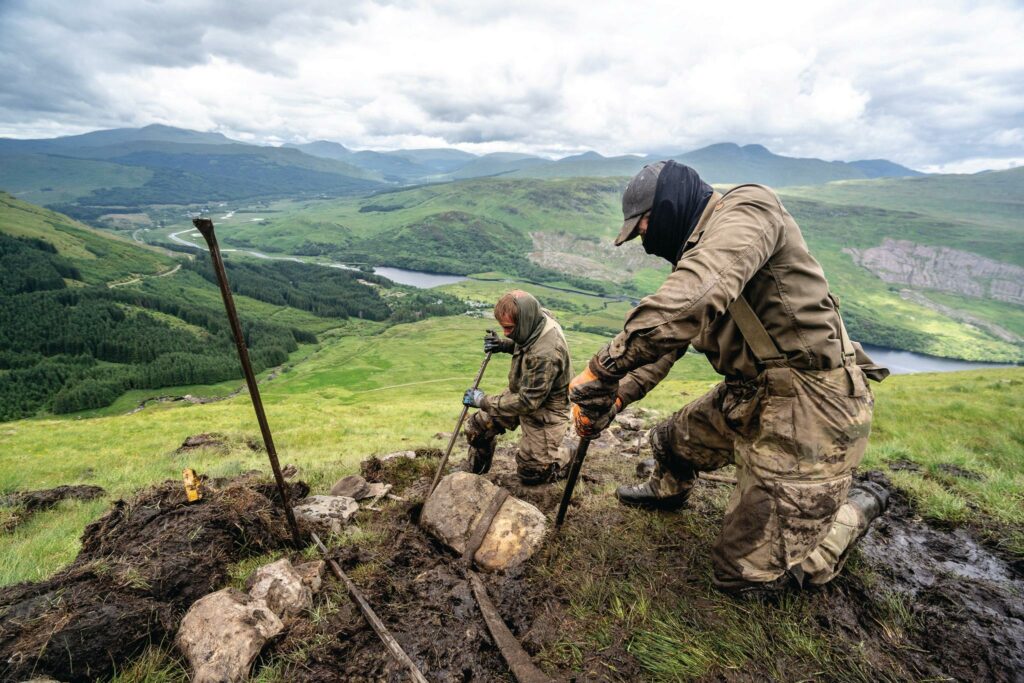
Many of Scotland’s footpaths are in need of repair, because there is no government investment to support mountain path and habitat restoration work beyond Scotland’s national parks. Mountaineering Scotland and the Outdoor Access Trust for Scotland (OATS) have therefore launched It’s Up to Us, a three-year campaign to raise money and awareness for critical footpath repairs on An Teallach, one of Scotland’s most iconic mountains. savemountainpaths.scot
MAKE DO AND MEND
HOW TO WATERPROOF A JACKET
Regular washing and reproofing using special ‘tech wash’ and proofer will keep your jacket waterproof – and prolong its life.
You will need: technical cleaning fluid; wash-in or spray-on proofing liquid; washing machine; tumble dryer
By Joe Pontin

1 First find and follow the jacket maker’s washing instructions on its website; labels on garments can be misleading. Note: normal washing powder or liquid may permanently damage the jacket’s waterproofing.

2 Run your empty washing machine on a rinse cycle to wash away any remnants of conventional detergent. Now use a proprietary ‘technical cleaner’ (e.g. from Granger’s or Nikwax) to wash the jacket in the machine.

3 Run the wash cycle a second time, this time adding a technical ‘proofing’ liquid to improve water repellency. Alternatively, apply a spray-on proofer to the damp jacket (this is recommended by some brands).

4 Some jackets benefit from ironing or drying in a tumble dryer as the heat activates the waterproofing, but check the brand’s online instructions first. Your jacket should now be waterproof.
ID GUIDE
FAIRYTALE FUNGI
Our islands are home to a staggering 15,000 species of fungi, many of which have an almost magical air. Expert forager Dave Hamilton reveals 12 of his favourites…
WARNING: ONLY PICK MUSHROOMS WITH AN EXPERT FORAGER
DEVIL’S FINGERS
Clathrus archeri
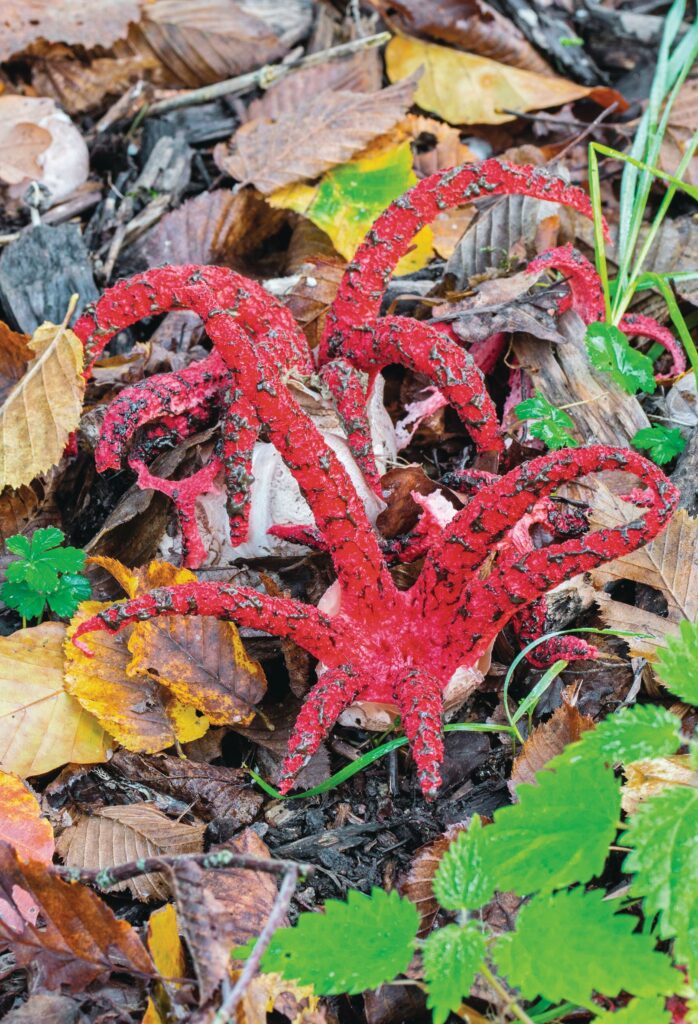
With the scent of rotten flesh and five to six red starfish-like tentacles, devil’s fingers (or octopus stinkhorn) looks like a visitor from another planet. This antipodean native is relatively rare in the UK but on the rise, thriving in woods and grasslands.
STINKHORN
Phallus impudicus
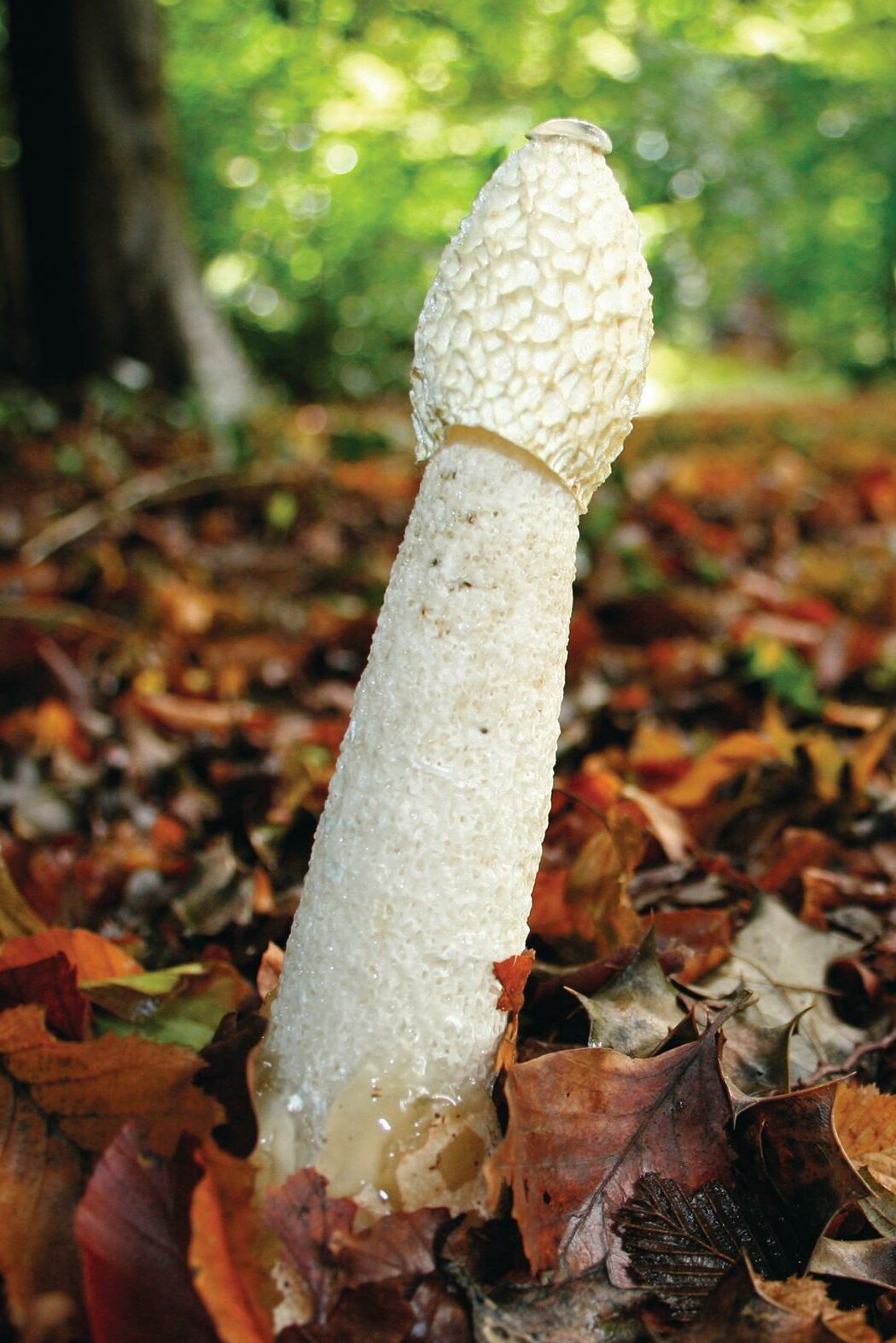
Beginning life in a gelatinous egg, the inside of which is edible, the stinking horn emerges to form a phallic-looking and rather stinky mushroom. The bad smell, not unlike rotten flesh, attracts flies that help spread the spores of this fascinating fungi.
KING ALFRED’S CAKES
Daldinia concentrica
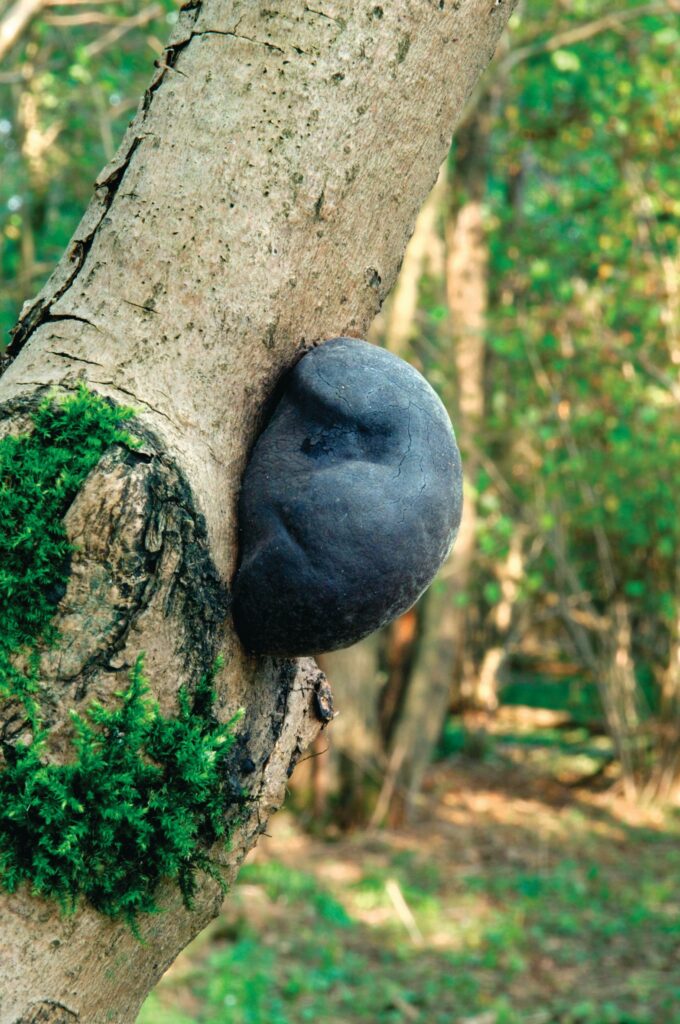
These hard black mushrooms, found on dead hardwood trees, are named after 9th-century King Alfred, who burnt the cakes of a peasant woman while hiding from Vikings. They light easily and have been used as firelighters since prehistoric times.
PORCELAIN FUNGUS
Mucidula (formerly: Oudemansiella) mucida
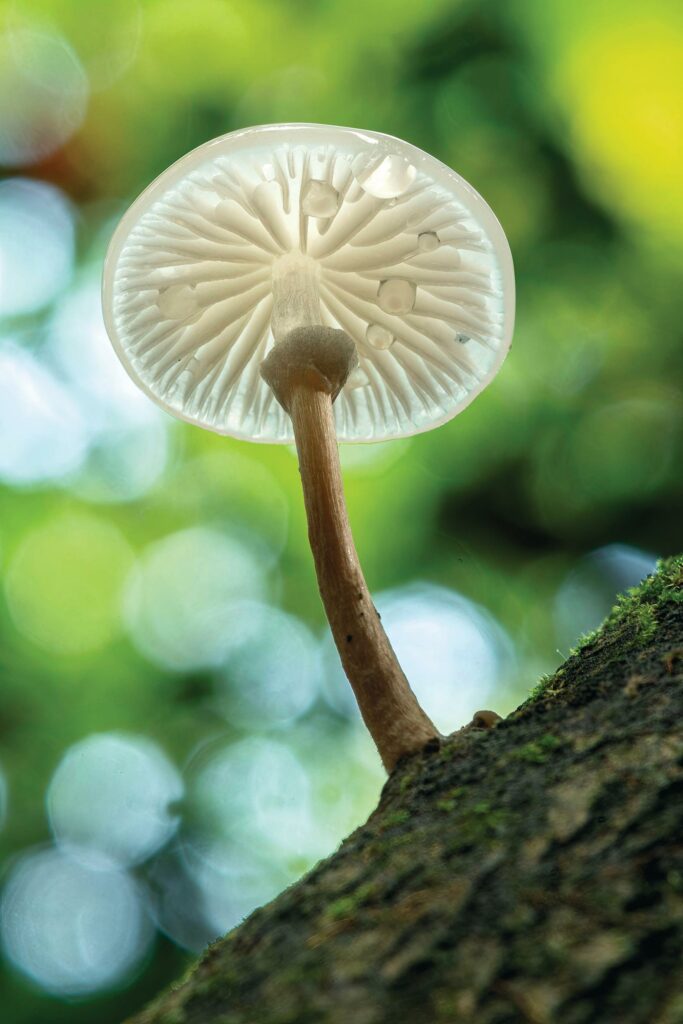
Growing on dead or dying beech wood, this white, late summer and autumn fungus looks like porcelain (albeit slimy porcelain). Edible and even considered a delicacy, the slimy coating needs to be washed off and it needs to be cooked well.
PARASOL
Macrolepiota procera
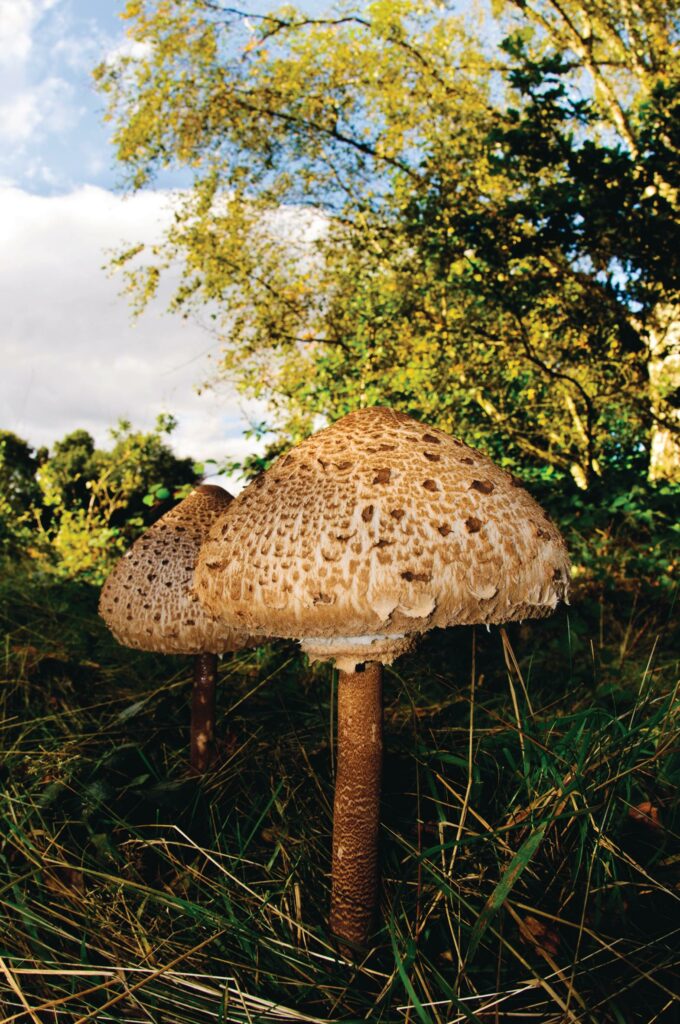
Growing in grassland, with caps as big as dinner plates, this parasol mushroom is one of the UK’s largest. Shaggy in appearance with a snakeskin pattern on the stem, it can be easy to ID (in the UK). The cap is edible and tasty and makes a great soup.
AMETHYST DECEIVER
Laccaria amethystina
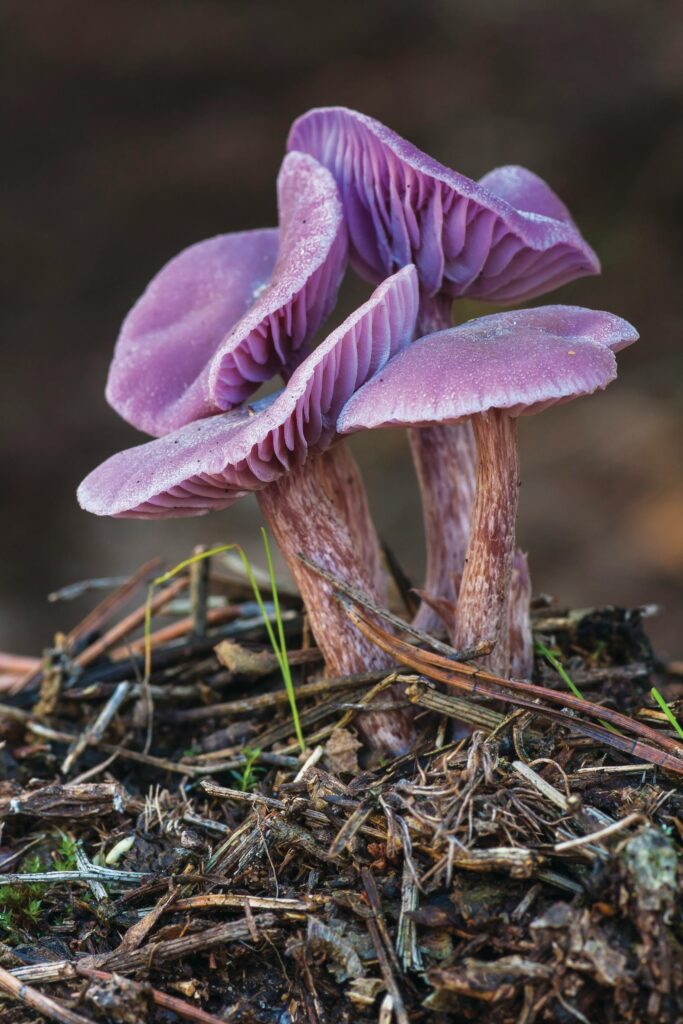
Beautiful, purple and edible, this small mushroom finds its home in mixed and broadleaf woodland. It can grow in really large numbers, making it a worthwhile addition to the foraging basket. Take care: it can resemble the poisonous lilac fibrecap.
MEADOW WAXCAP
Cuphophyllus pratensis
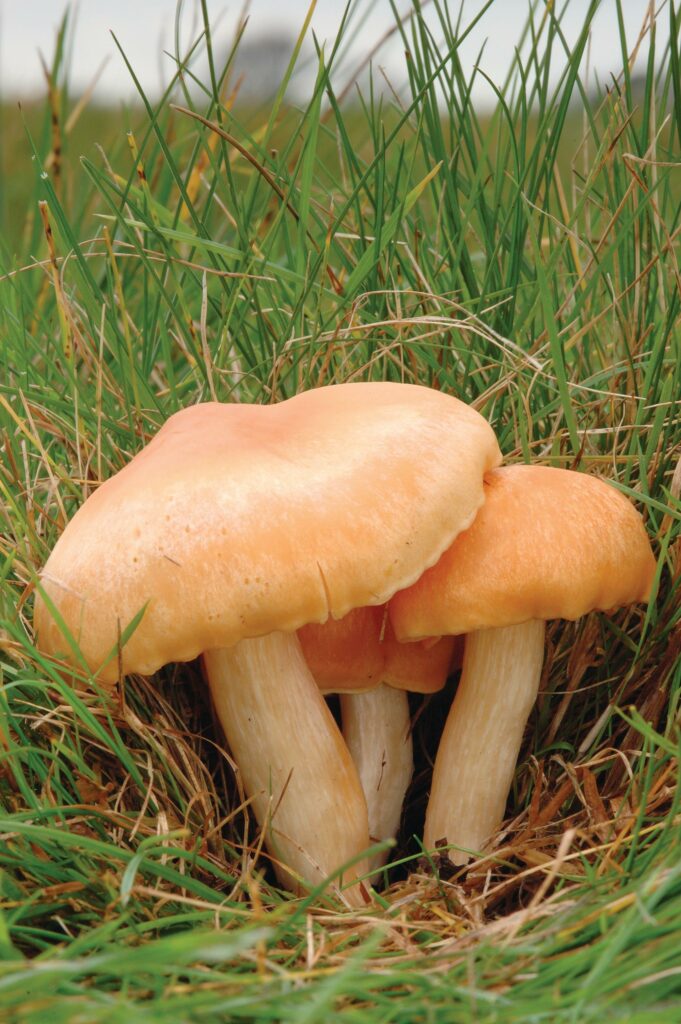
Perhaps unsurprisingly, this is a waxy mushroom, which grows in meadows and grasslands. It has widely spaced, decurrent (running down the stem) gills and an orange, fading-to-white cap. Many relatives grow in the UK, but this is the best to eat.
SAFFRON MILKCAP
Lactarius delicious
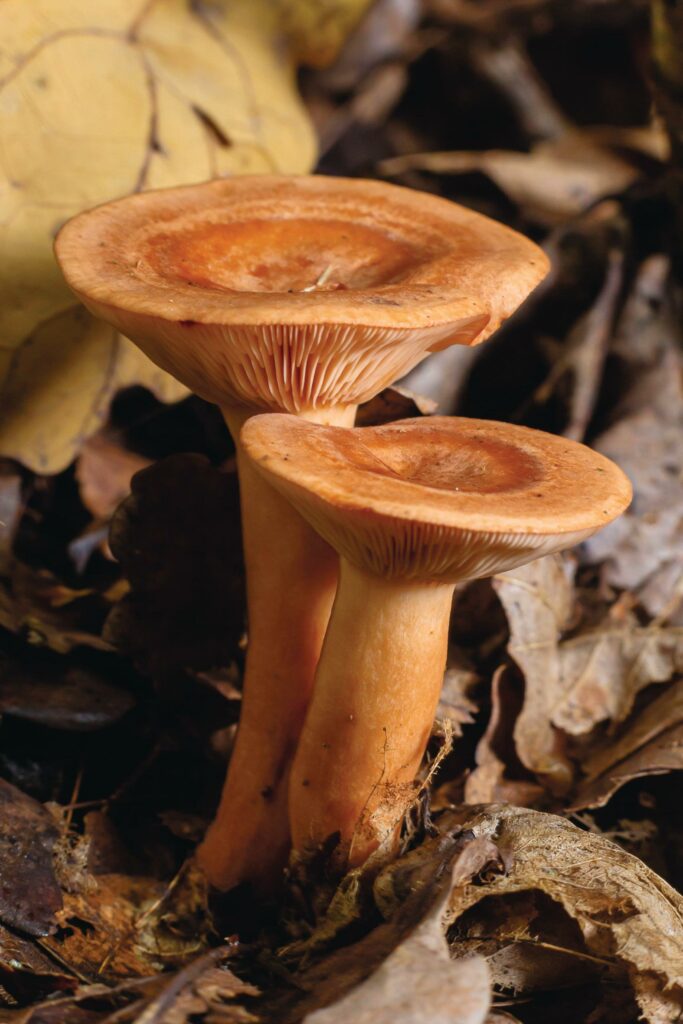
This delicious mushroom bleeds a bright carrot-orange liquid when cut. It is more common in northern England and Scotland, where it’s found in pine woods. Pictures of the mushroom were found in the Roman ruins of Herculaneum.
CHARCOAL BURNER
Russula cyanoxantha
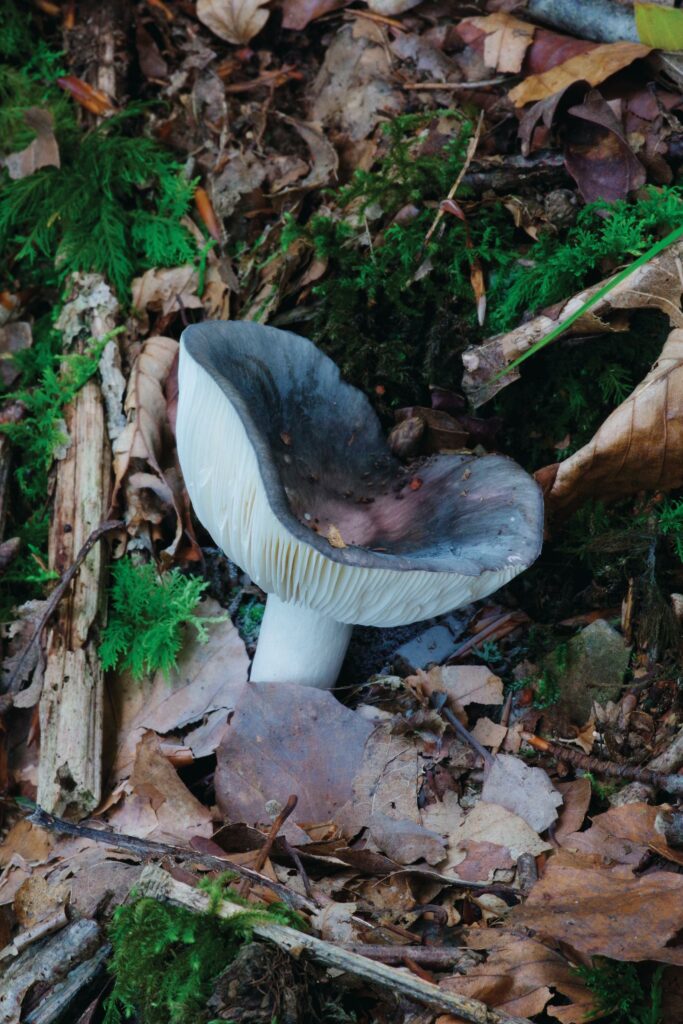
A common but overlooked edible mushroom, the charcoal burner is a member of the Russula genus, commonly known as brittlegills, but it has flexible rather than brittle gills. ID is crucial as there are toxic members of this family (all of which have a hot, chilli-like taste) and poisonous lookalikes.
DEVIL’S BOLETE
Rubroboletus satanas
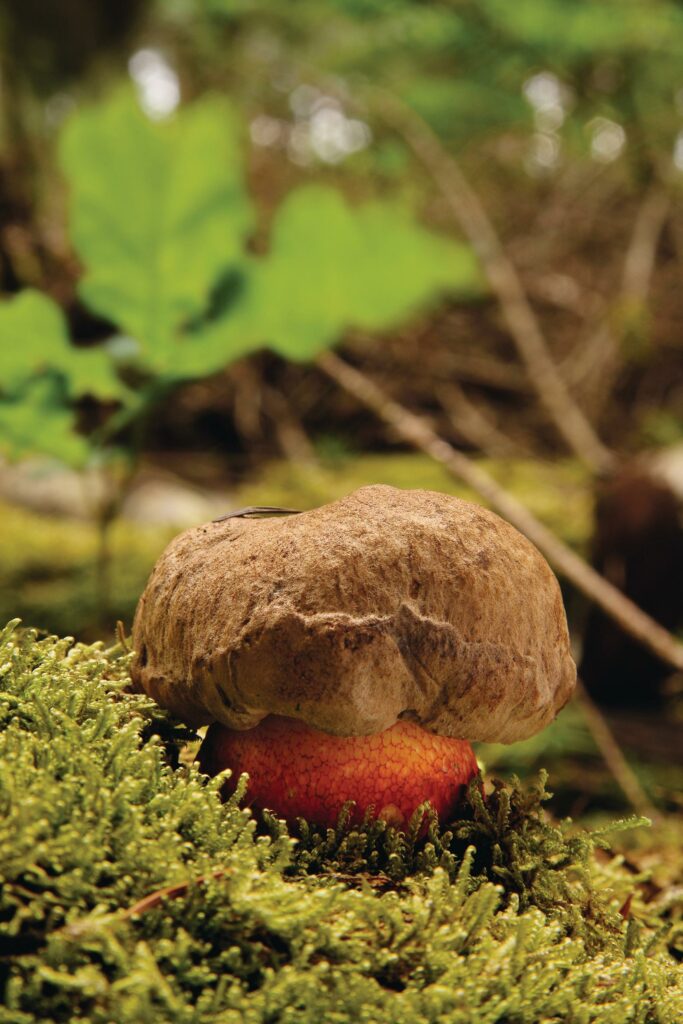
A large, late summer to early autumn mushroom with spongey red pores rather than gills and a red stem. Both poisonous and rare, it must not be picked. If cut, the flesh will stain blue.
DEATHCAP
Amanita phalloides
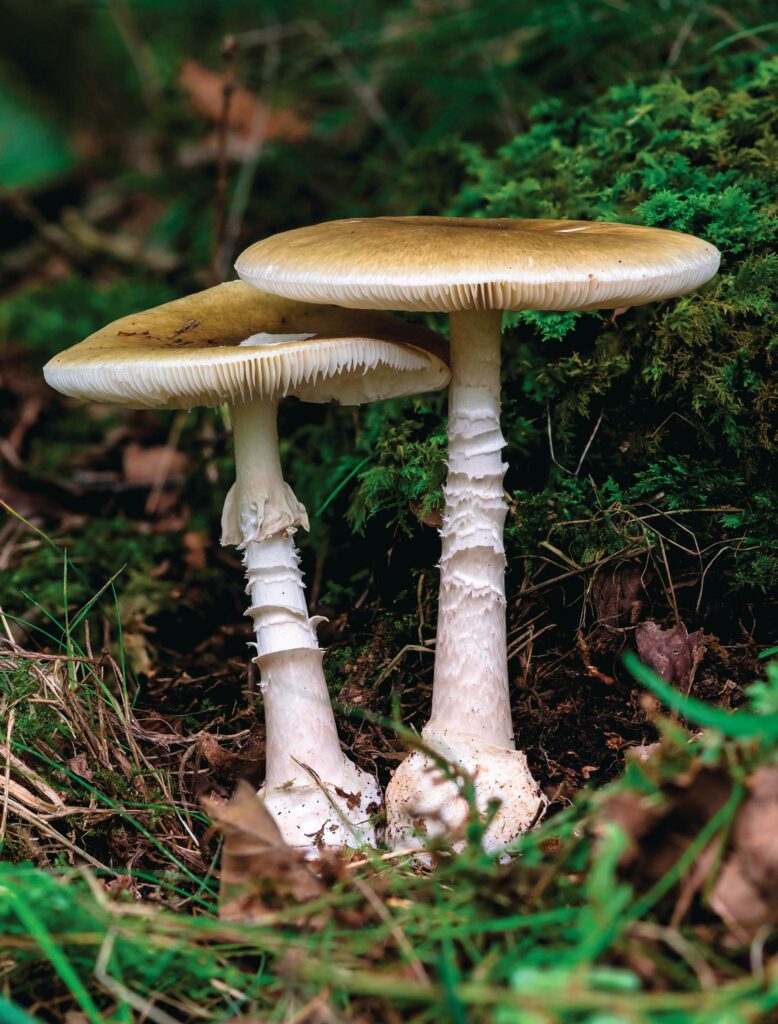
Containing deadly amatoxins, just one deathcap is enough to kill a fully grown adult. Growing from an egg sack, when young it can be confused for the more innocent puffball mushroom. However, most poisonings have occurred because it looks like the paddy straw mushroom that grows in the Far East.
DEADLY WEBCAP
Cortinarius rubellus
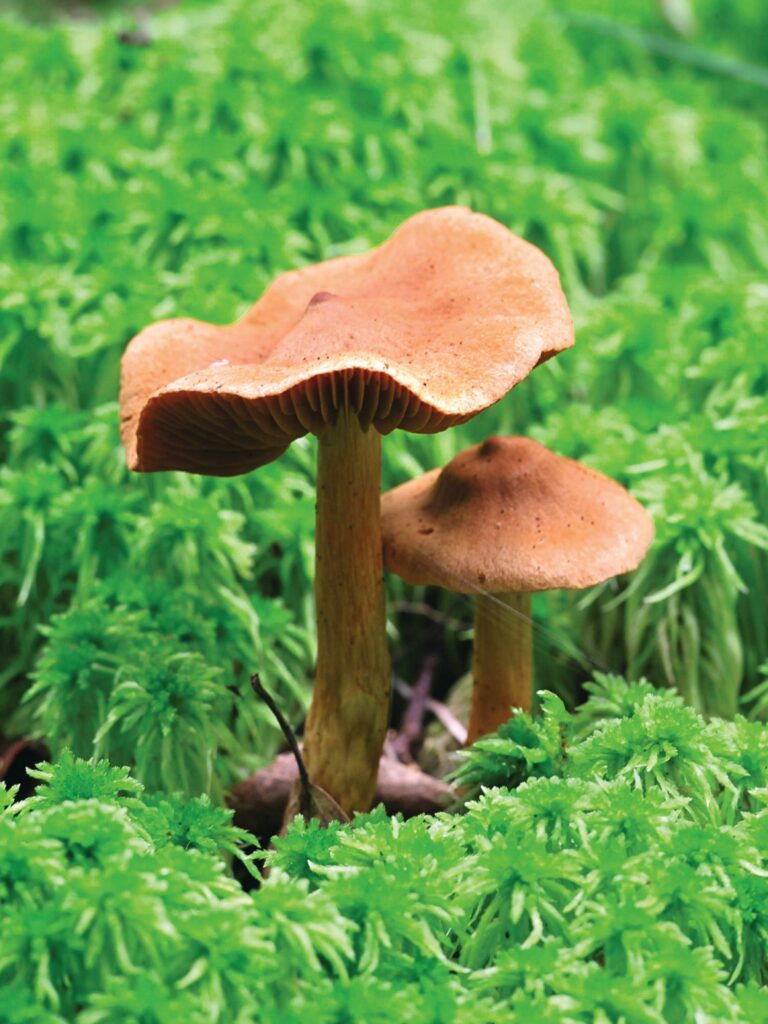
Containing the nephrotoxic compound orellanine (toxic to the kidneys), 22 of the 28 patients who have been taken into hospital having consumed the deadly webcap have developed acute kidney injury. The name webcap refers to the mass of fine, web-like fibres between the cap and the stem.

Dave Hamilton is the author of Where the Wild Things Grow, A Forager’s Guide to the Landscape. He works as an instructor for foraging course company, Wild Food UK.
HARVEST RECIPES SPECIAL
Make the most of the season’s bounty with these delicious and comforting recipes from Gill Meller, to cook and eat outdoors in autumn’s golden light, or indoors as you wish
A SIMPLE CAMPFIRE LOAF
Cooking bread in the embers of a fire might seem like a trivial achievement, but in reality it’s quite the opposite. In that bread, we get a glimpse of our evolution, our history and even our future. We see humankind’s capacity to survive, to learn and to adapt. The bread itself represents our reliance on the land – it encapsulates the domestication of plants and the consumption of their seeds, the very bones of agriculture.
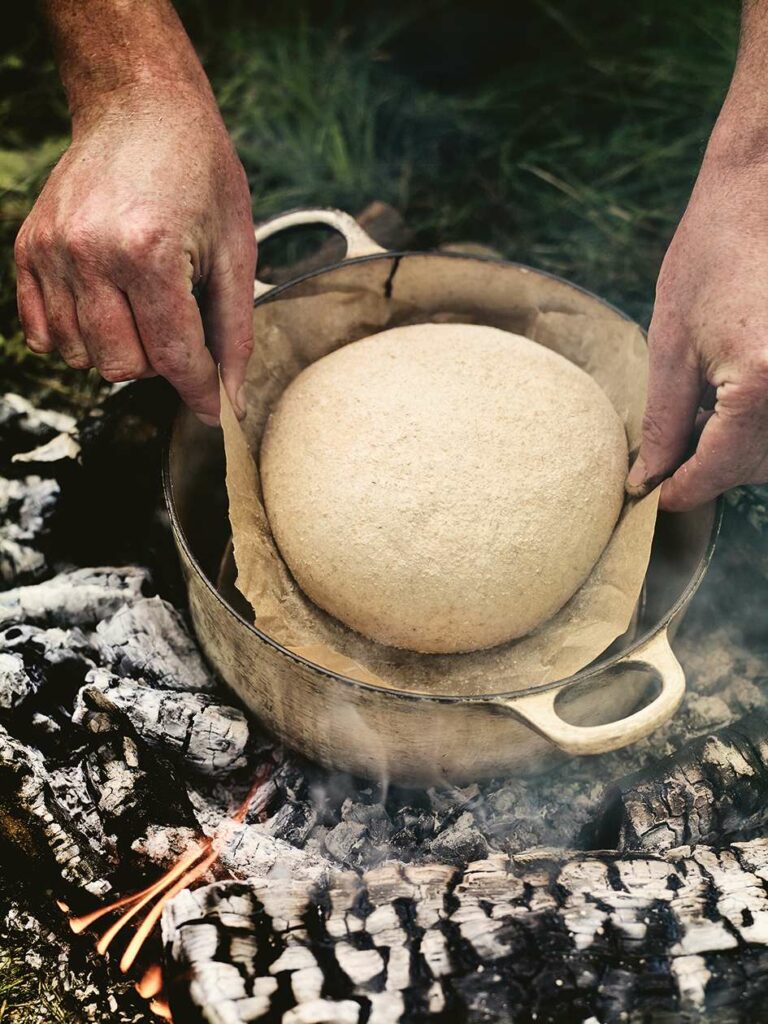
MAKES 1 LOAF
• 50g strong white bread flour, plus extra for dusting
• 250g wholemeal (wholewheat) flour
• 1 heaped tsp quick yeast
• 1 heaped tsp sea salt
METHOD
1 Combine the flours, yeast and salt in a large bowl. Add 320ml of water and mix until the dough starts to come together. You can knead the dough in the bowl by stretching it out, then folding it in on itself, or turn it out on to a floured surface and knead it. Do this for five mins. Shape the dough into a round, return it to the bowl and cover with a damp tea towel. Leave to rise in a warm place until doubled in size, which should take an hour or so, but can take 2–3 hours if the day is cold.
2 Turn out the risen dough on to a board – this will knock a lot of the air out of it. Gently stretch the top and bottom edges and fold them into the middle. Repeat with the left and right edges. With each fold, crimp the seam of the edges together. Turn the dough over and use your hands to form it into a nice, tight round shape. Cut out a round of baking paper, about 30cm in diameter, and place the dough on it. Scatter over a little flour and leave it to rise for 30 minutes.
3 Light the fire, if it’s not going already. You want a mixture of burning wood and hot, chunky, glowing embers. Take a large, heavy-based, cast-iron pot or Dutch oven. Place 3–4 pebbles over the bottom and lay the base of a springform cake tin on top. When your fire is ready, level off an area within it, so the pot will sit evenly. Put the lid on the pot and place it in the fire to heat up.
4 When the dough is ready and the pot is hot, lift the lid. Pick up the dough by the edges of the paper and lower into the pot. Put on the lid; use tongs to put embers around and on top of the pot. Bake for up to one hour, keeping the heat consistent by shuffling the embers, feeding the fire and rotating the pot every 10–15 mins. To test the loaf is done, take it out and tap its underside; it should sound hollow. Lift out of the pot and let it cool a bit before eating.
SQUASH, BARLEY, BLUE CHEESE AND WALNUT SALAD
I used to think autumn was my favourite season, but now, as I look out of the window, I realise I love all four seasons, equally. Cooking helps me remember this. Everything I make is tangled up in the shifting patterns of the year, but I’ll make most things I like to eat only once or twice over that time. It is the forgetting that makes every dish special.
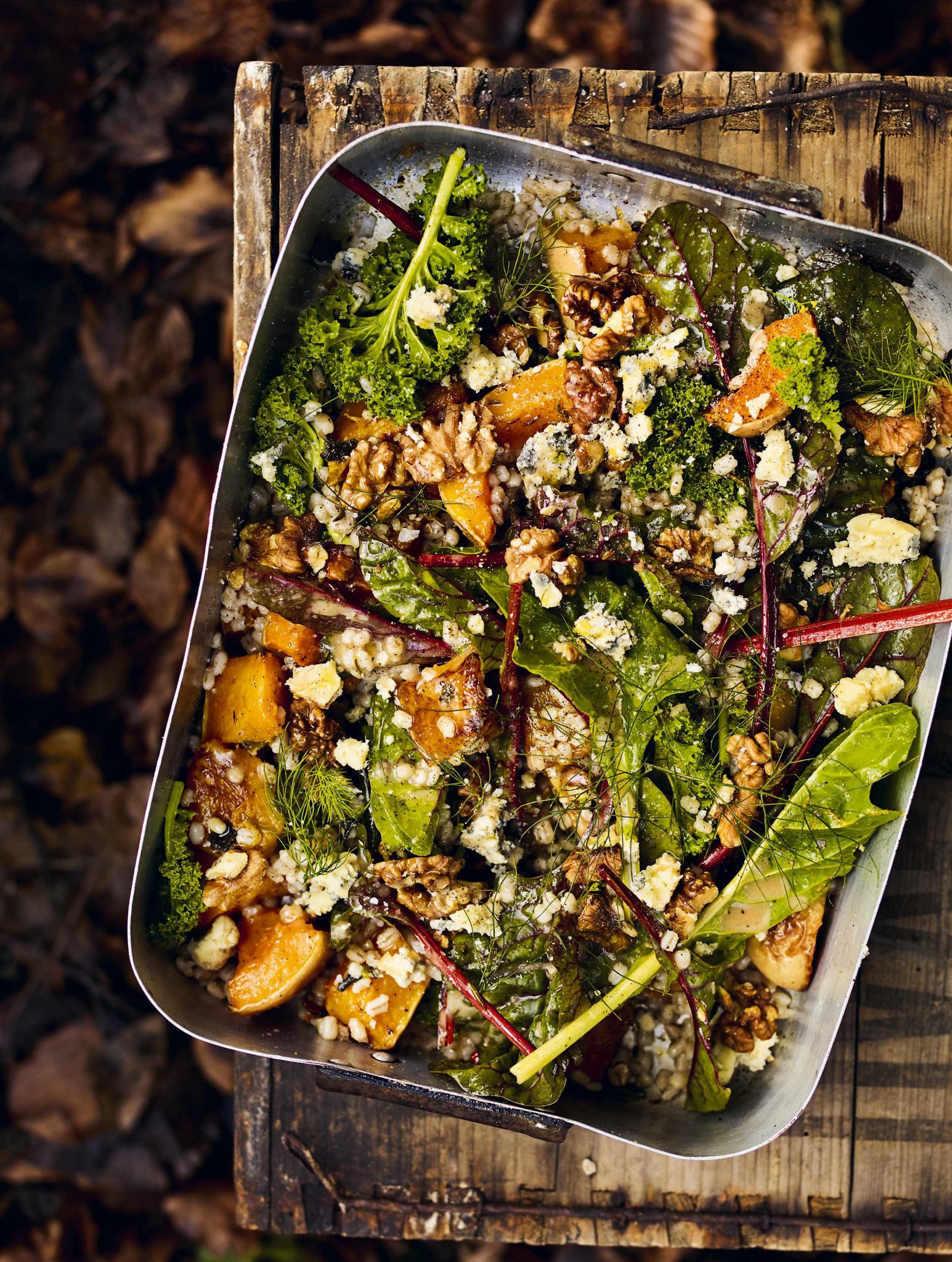
SERVES 4
• 100g pearled barley
• 1 squash, such as a crown prince or butternut or a couple of onion squash
• 4 garlic cloves, thickly sliced
• 2 tbsp extra-virgin olive oil
• A small handful of sage leaves
• A small handful of rosemary sprigs
• A handful of walnut halves
• A few handfuls of salad leaves (I’ve used some small kale and chard leaves, as well as fennel tops)
• 75g your favourite soft blue cheese
• Sea salt and freshly ground black pepper
For the dressing
• 4 tbsp extra-virgin olive oil
• 2 tbsp sunflower oil
• 2 tbsp red wine vinegar
• 2 tsp Dijon mustard
• 2 tsp unrefined caster (superfine) sugar
• 1 small garlic clove, very finely grated, or crushed to a paste
METHOD
1 Heat the oven to 200°C/180°C fan/400°F/Gas 6. First, make the dressing. Put all the ingredients in a small jug, season, and whisk until thoroughly combined. Set aside.
2 Rinse the pearled barley well, then put it in a large pan and cover with plenty of cold water. Set the pan over a medium–high heat and bring it to a boil. Reduce the heat and simmer for about 20–30 minutes, or until the grains are tender. Drain well, then while the barley is still warm, spoon over a third of the dressing, season with salt and pepper and toss together.
3 While the barley is cooking, halve and deseed the squash. If it needs peeling, do this, too. Cut the squash into large bite-size chunks. Scatter the squash and sliced garlic cloves over a roasting tin. Trickle over the extra-virgin olive oil and tear over the sage leaves and rosemary sprigs. Season with salt and pepper and tumble together. Roast for 45–50 minutes, turning occasionally or until everything is soft, sweet and caramelised. At this point scatter in the walnut halves – you can break them up a bit if you like – and the cooked barley. Return the tray to the oven for five minutes, then remove it, turn everything once more, then allow to cool to room temperature.
4 Wash and spin-dry the leaves you have decided to use. Tumble these through the salad, right there in the roasting tin. Crumble over the blue cheese and trickle over the remaining dressing before serving.
PLUM AND BLACKBERRY CRUMBLE
Plums have such an incredible, rich flavour when you bake them and are stunning with blackberries. This one’s topped with an oat and hazelnut topping, which is particularly crunchy, making seconds all the more difficult to resist.
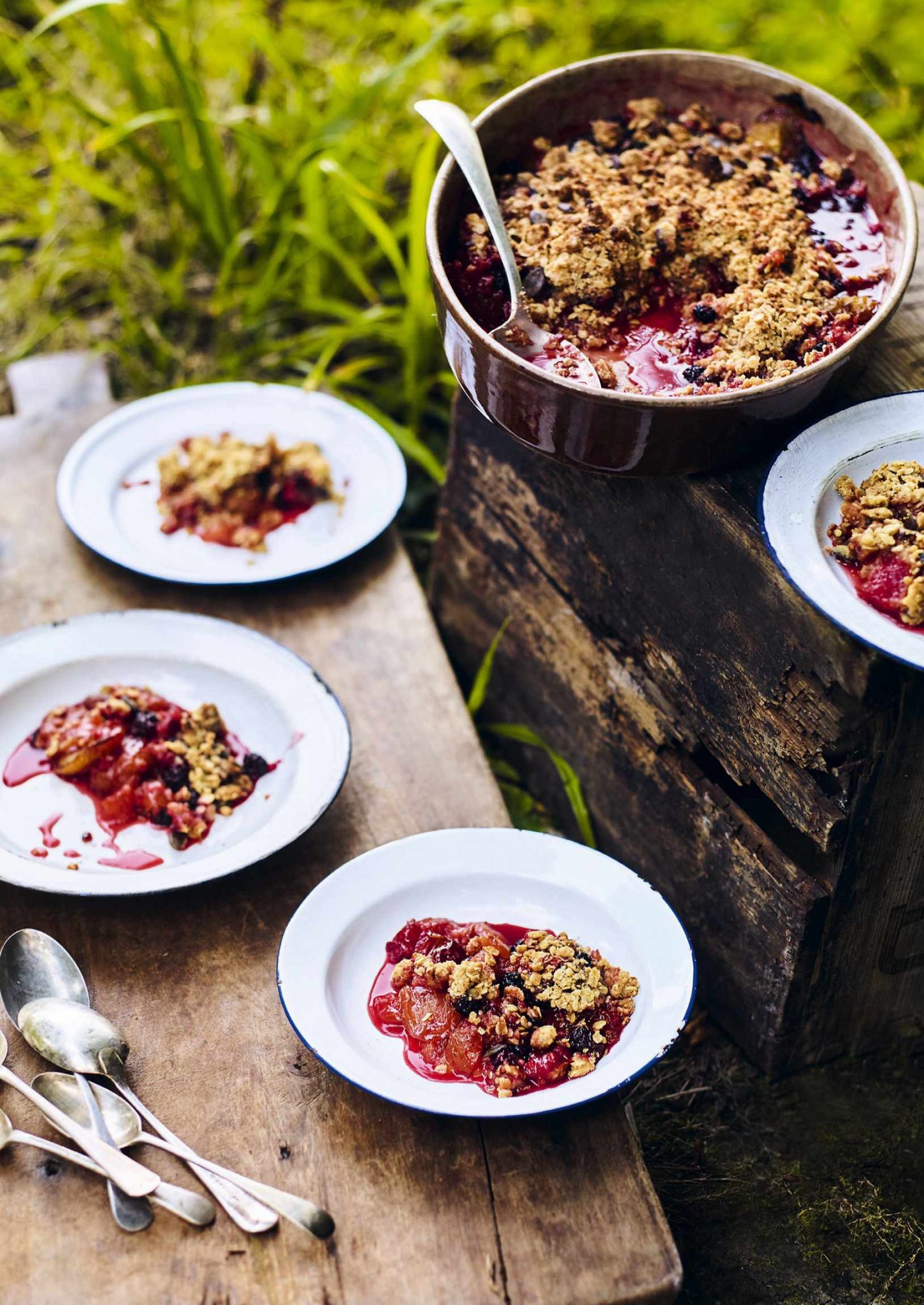
SERVES 6–8
• About 1.5kg ripe plums, halved and stoned
• Finely grated zest of 1 lemon
• 100g caster (superfine) sugar
• 2 tbsp runny honey
• 1 rosemary sprig, leaves picked and finely chopped (optional)
• About 300g blackberries
For the crumble
• 200g plain (all-purpose) flour
• 150g porridge oats (oatmeal)
• 50g hazelnuts, roughly chopped
• 200g unsalted butter, cubed and chilled
• 75g caster (superfine) sugar
• 75g light brown soft sugar
• A pinch of sea salt
METHOD
1 First, make the crumble. Heat the oven to 175°C/155°C fan/gas 3–4. Combine all the crumble ingredients in a large bowl and rub them thoroughly together until you have formed clumps and lumps. Line a large baking sheet with a piece of baking paper. Tip out the mixture on to the sheet and distribute it evenly. Pop the tray in the middle of the oven and bake the crumble for 25–30 mins, turning the mixture over three or four times during baking, until it’s clumped together, biscuity and golden.
2 Meanwhile, make the filling. Arrange the halved plums, cut side up, in a large baking dish. Sprinkle over the lemon zest and sugar and trickle over the honey. If you like the idea of using a hint of rosemary with the plums, scatter the chopped leaves over now. Place the dish of plums in the oven and cook until they just start to soften (about 10–25 minutes, depending on the variety and ripeness of the plums).
3 If there’s lots and lots of plum juice, spoon this off into a pan, reduce it by three-quarters and put it back over the fruit. If there’s not much juice, simply skip this process altogether. Scatter the blackberries over the plums.
4 Give everything a very gentle stir, so as not to break up the fruit too much, then spoon the crumble mixture on top in a nice, even layer. Return the dish to the oven and cook for a further 10 minutes, or until the plum and blackberry juices are bubbling away and the crumble is golden and irresistible.
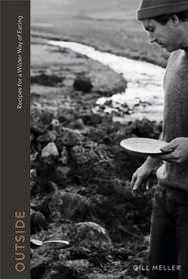
Recipes from Outside: Recipes for a Wilder Way of Eating by Gill Meller (Quadrille, £30).